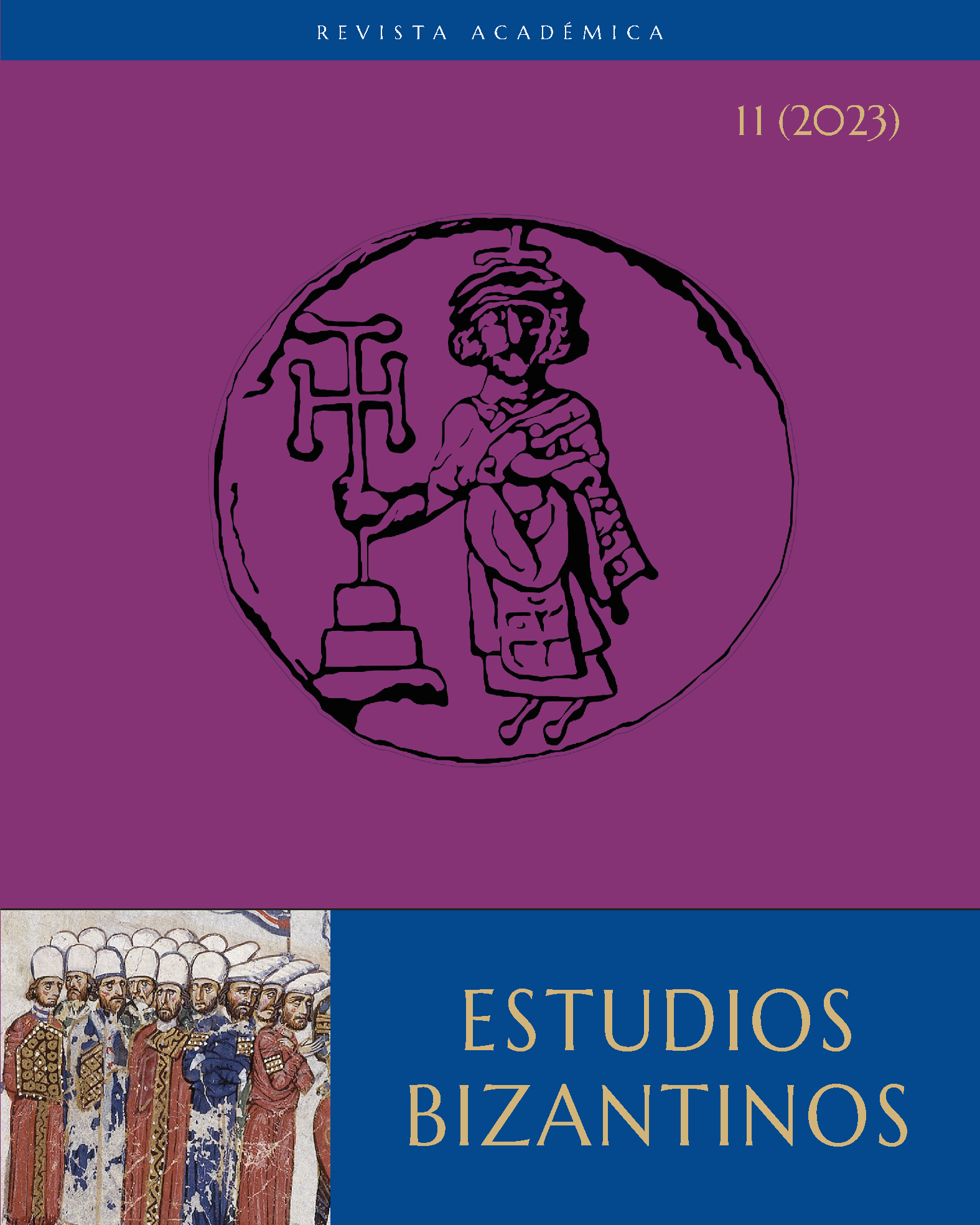Ornament and Status: Three Early Palaeologan Illuminated Manuscripts
DOI:
https://doi.org/10.37536/ebizantinos.2023.11.2393Keywords:
Vatican Epithalamion, Palaeography, Illuminated ManuscriptsAbstract
The ‘Vatican Epithalamion’ (BAV Vat. gr. 1851) was recently dated by Peter Schreiner to 1271 or 1272. In this paper, I present an additional argument for his dating by comparing the Epithalamion’s zoomorphic initial letters with those found in two other codices datable to the reign of Michael VIII Palaeologus: a Gospelbook (Mount Athos, Iviron Monastery, 5) and a Psalter (Jerusalem, Greek Patriarchal Library, Παναγίου Τάφου 51). This comparison suggests also that zoomorphic ornament functioned at the time as a marker of social status.
Downloads
References
Anderson, J. C. 1991, “The Illustrated Sermons of James the Monk: Their Dates, Order, and Place in the History of Byzantine Art”, Viator 22, 69-120.
Boojamra, J. L. 1993, The Church and Social Reform: The policies of the Patriarch Athanasios of Constantinople, New York.
Buchthal, H./Belting, H. 1978, Patronage in Thirteenth-Century Constantinople: An Atelier of Late Byzantine Book Illumination and Calligraphy (Dumbarton Oaks Studies 16), Washington DC.
Bender, L./ Parani, M./ Pitarakis, B./ Spieser, J.-M./ Vuilloud, A. ByzAD: Artefacts and Raw Materials in Byzantine Archival Documents / Objets et matériaux dans les documents d’archives byzantins, on-line at http://typika.cfeb.org.
Ćurčić, S. 1995, “Some Uses (and Reuses) of Griffins in Late Byzantine Art”, in D. Mouriki (ed.), Byzantine East, Latin West: Art-Historical Studies in Honor of Kurt Weitzmann Princeton, 597-604.
Cutler, A. 1984, The Aristocratic Psalters in Byzantium (Bibliothèque des Cahiers archéologiques 13), Paris.
Galavaris, G. 2002, Holy Monastery of Iveron: The Illuminated Manuscripts, Mount Athos.
Hilsdale, C. J. 2005, “Constructing a Byzantine Augusta: A Greek Book for a French Bride”, Art Bulletin 87, 458-483.
Huber, P. 1980, Heilige Berge: Sinai, Athos, Golgotha - Ikonen, Fresken, Miniaturen, Zurich.
Iacobini, A. 1995, “L’epitalamio di Andronico II. Una cronaca di nozze della Costantinopoli Paleologa”, in Iacobini, A. / Zanini, E. (eds.), Arte profana e arte sacra a Bisanzio (Milion: Studi e ricerche d’arte bizantina 3), Rome, 361-410.
Kitzinger, E. 1963 “Some Reflections on Portraiture in Byzantine Art”, ZRVI 8, 185-193; repr. in id.1976, The Art of Byzantium and the Medieval West: Selected Studies, Bloomington.
Konstantinos D. et al. 2004, The World of the Byzantine Museum, Athens.
Loeschke, W. “Griff ans Handgelenk”, in Wessel K. (ed.), Reallexikon zur byzantinischen Kunst, II, Stuttgart 1971, 940-944.
Macrides R. et al. 2013, Pseudo-Kodinos and the Constantinopolitan Court: Offices and Ceremonies, Farnham.
Maxwell, K. 1983, “Another Lectionary of the ‘Atelier’ of the Palaiologina, Vat. gr. 352”, DOP 37, 47-58.
Maxwell, K. 2014, Between Constantinople and Rome: An Illuminated Byzantine Gospel Book (Paris Gr. 54) and the Union of Churches, Burlington (VT).
Millet, G. 1911, “Portraits byzantins”, Revue de l’art chrétien 11, 445-451.
Nelson, R. S. - Lowden, J. 1991, “The Palaeologina Group: Additional Manuscripts and New Questions”, DOP 45, 59-68.
Nicholas, N. 1999, “A Conundrum of Cats: Pards and Their Relatives in Byzantium”, GRBS 40 253-298.
Parani, M. 2007, “Cultural Identity and Dress: The Case of Late Byzantine Ceremonial Costume”, JÖB 57, 95-134.
Pelekanidis S. et al. 1975, The Treasures of Mount Athos: Illuminated Manuscripts, II, Athens.
Pérez Martín, I. 2019, “Mi gran boda bizantina: el epitalamio ilustrado del Vat. gr. 1851”, Boletín de la Sociedad Española de Bizantinística 33, 6-11.
Prato, G. 1979, “Scritture librarie arcaizzanti della prima età dei Paleologi e loro modelli”, Scrittura e civiltà 3, 151-193.
Rhoby, A. 2018, “Hunde in Byzanz, in Drauschke J. et al. (eds.), Lebenswelten zwischen Archäologie und Geschichte: Festschrift für Falko Daim zu seinem 65. Geburtstag (Monographien des RGZM 150), Mainz, 807-820.
Rhoby, A./Stefec, R. 2018, Ausgewählte byzantinische Epigramme in illuminierten Handschriften: Verse und ihre “inschriftliche” Verwendung in Codices des 9. bis 15. Jahrhunderts (Veröffentlichungen zur Byzanzforschung 42), Vienna.
Schreiner, P. 2019, “Anna von Frankreich (1180) oder Anna von Ungarn (1272)? Historische und prosopographische Anmerkungen zum illustrierten Brautgedicht im Vaticanus gr. 1851”, in E. Juhász (ed.), Byzanz und das Abendland VI: Studia Byzantino Occidentalia (Antiquitas - Byzantium - Renascentia 38), Budapest, 81-108.
Soteroudes, P. 1998, Ἱερὰ Μονὴ Ἰβήρων: Κατάλογος ἑλληνικῶν χειρογράφων, I, Mount Athos.
Spatharakis, I. 1976, The Portrait in Byzantine Illuminated Manuscripts (Byzantina Neerlandica 6), Leiden.
Strzygowski, J. 1901, “Das Epithalamion des Paläologen Andronikos II.”, BZ 10, 546-567.
Tsamakda, V. 2023, “Die Illustrationen des Vat.gr.1851 und ihr Verhältnis zum Text”, Studi e testi (forthcoming).
Vocotopoulos, P. L. 2002, Byzantine Illuminated Manuscripts of the Patriarchate of Jerusalem, Athens-Jerusalem.
Weitzmann, K. 1957, “Eine Pariser-Psalter-Kopie des 13. Jahrhunderts auf dem Sinai”, JÖB 6 125-143.
Downloads
Published
How to Cite
Issue
Section
License
Copyright (c) 2023 Georgi Parpulov

This work is licensed under a Creative Commons Attribution-NonCommercial-ShareAlike 4.0 International License.
You are free to:
- Share — copy and redistribute the material in any medium or format
- Adapt — remix, transform, and build upon the material
Under the following terms:
-
Attribution — You must give appropriate credit, provide a link to the license, and indicate if changes were made. You may do so in any reasonable manner, but not in any way that suggests the licensor endorses you or your use.
-
NonCommercial — You may not use the material for commercial purposes.
-
ShareAlike — If you remix, transform, or build upon the material, you must distribute your contributions under the same license as the original.
-




